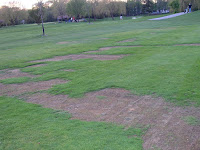Here's a photo from late-April of 2007 after a "bad winter":
Turf can die over the winter for a lot of reasons. In this area, the most common causes are snow mold and something called "crown hydration." The crown of the grass plant contains its growing point located at the base of the leaf blades (see photo). If the crown is damaged, the plant will die. During dormant periods, the crown attempts to protect itself from its environment, but complete dessication or freezing can damage the tissue.
Over the winter, ice is often blamed for turf loss; but the ice itself is often not to blame. Over the past several years at Sugar Creek, I've found the real culprit is crown hydration and freezing late in winter. The worst winterkill I've seen here became visible in spring 2007. Ironically, this came after a very mild winter. Last spring, 2009, we experienced virtually no winterkill and it was a colder than average winter with the turf locked in ice for a long period. The reason for this is crown hydration and tempurature change.
Kevin Frank of Michigan State writes:
During the warm days of late winter, annual bluegrass plants start to take up water (hydrate). Potential for injury exists when a day or two of warm daytime temperatures in late winter is followed by a rapid freeze. The most common time for winterkill associated with crown hydration and refreezing to occur is during the late winter and early spring when there is snowmelt or rainfall and then refreezing of the water that has not drained away. ("Winterkill of Turfgrass")This perfectly describes what we've seen in this area. So far, the turf at Sugar Creek appears healthy. It is the critical period coming up that will determine how much we may have to repair. We will be keeping a close eye on freezing and thawing cycles in the next 6 weeks to aid in planning our spring projects. What I would like to see is an early warm-up that stays warm. No "fake-outs"!
Added 1/30/2010: I was asked by a friend if this is something a homeowner might have to worry about. The answer: Probably not. It could happen if your property happens to have an area with bad drainage, like a low area at the rear of the property, but most properties slope away from the house sufficiently to avoid winterkill. In addition, a typical lawn of Kentucky Bluegrass cut at 2.5" or 3" is not very susceptible to crown hydration damage, while a close cut fairway or tee with a mix of different species can be. Like a lot of front lawns, our greens are elevated and sloped back to front so they rarely experience crown hydration damage.
If you have experienced winter injury, the best course of action is to re-plant the area in the spring, which I'll talk about in a later post, and improve the drainage in the area that died.
If you would like to read more about winter damage, you can check out these studies "Understanding Crown Hydration Damage", "Winter Crown Hydration Injury on Turf", and "Field Assessment of Winter Injury".













No comments:
Post a Comment